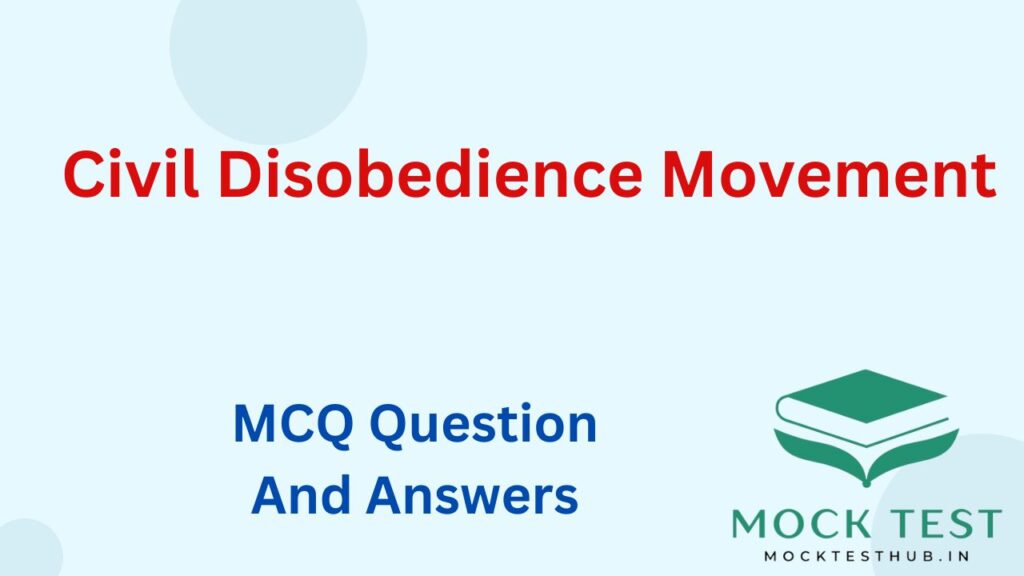
The “Savinay Avagya Aandolan,” or Civil Disobedience Movement, was one of the major movements in India’s struggle for independence from British rule. It was launched by Mahatma Gandhi on 12th March 1930 with the famous Salt March. This movement was based on the principle of non-violence and non-cooperation with the British government.
Key Points:
- Objective: The main objective was to defy British laws peacefully, especially the salt tax, which imposed a heavy burden on the poor.
- Salt March: Gandhi’s 240-mile march from Sabarmati Ashram to Dandi was a symbolic act of defiance against the British salt monopoly.
- Non-Violent Protest: The movement was centered on peaceful protests, where Indians were encouraged to break laws non-violently and face arrest if necessary.
- Impact: It led to widespread protests, strikes, and demonstrations all across the country. The British government responded by arresting thousands of leaders, including Gandhi.
- Role of Women and Youth: The movement saw the active participation of women and youth, strengthening the fight for independence.
- Outcome: Although the British did not immediately grant independence, the Civil Disobedience Movement significantly weakened British authority and marked a turning point in the freedom struggle.
MCQs for Students:
- Who led the “Savinay Avagya Aandolan”? a) Jawaharlal Nehru
b) Subhas Chandra Bose
c) Mahatma Gandhi
d) Sardar Patel
Answer: c) Mahatma Gandhi - When did Mahatma Gandhi begin the Salt March? a) 12th March 1930
b) 15th August 1942
c) 26th January 1930
d) 30th November 1935
Answer: a) 12th March 1930 - What was the main purpose of the Civil Disobedience Movement? a) To fight against British education system
b) To break the salt law
c) To promote industrial growth
d) To seek equality for all
Answer: b) To break the salt law - Where did the Salt March begin? a) Dandi
b) Sabarmati Ashram
c) Ahmedabad
d) Delhi
Answer: b) Sabarmati Ashram - What was the significance of the Salt March? a) It was a protest against untouchability
b) It was a symbol of unity among Indians
c) It was a protest against high taxes
d) It was a protest against British salt tax
Answer: d) It was a protest against British salt tax - Which of the following was a major result of the Civil Disobedience Movement? a) End of British colonial rule
b) Mass arrests of leaders and common people
c) Economic reforms
d) Establishment of an independent India
Answer: b) Mass arrests of leaders and common people - Which of these laws did Gandhi urge people to disobey? a) The Rowlatt Act
b) The Salt Law
c) The Forest Law
d) The Vernacular Press Act
Answer: b) The Salt Law - Who was arrested along with Gandhi during the movement? a) Jawaharlal Nehru
b) Lala Lajpat Rai
c) Sardar Patel
d) All of the above
Answer: d) All of the above - What was the British response to the Salt March? a) They ignored it
b) They arrested Gandhi and other leaders
c) They reduced taxes
d) They increased repression
Answer: b) They arrested Gandhi and other leaders - Which group played a prominent role in the Civil Disobedience Movement? a) Farmers
b) Women
c) Lawyers
d) Students
Answer: b) Women - Which term best describes the nature of the Civil Disobedience Movement? a) Violent
b) Non-violent
c) Militarized
d) Political
Answer: b) Non-violent - What was the slogan associated with the Civil Disobedience Movement? a) “Quit India”
b) “Do or Die”
c) “Satyagraha”
d) “Inquilab Zindabad”
Answer: c) “Satyagraha” - Which city was Gandhi’s destination for the Salt March? a) Ahmedabad
b) Dandi
c) Lucknow
d) Varanasi
Answer: b) Dandi - Who was the Viceroy of India during the Civil Disobedience Movement? a) Lord Mountbatten
b) Lord Curzon
c) Lord Irwin
d) Lord Wavell
Answer: c) Lord Irwin - What was one of the key symbols of the Civil Disobedience Movement? a) Khadi
b) Salt
c) Tricolor Flag
d) Charkha
Answer: b) Salt

